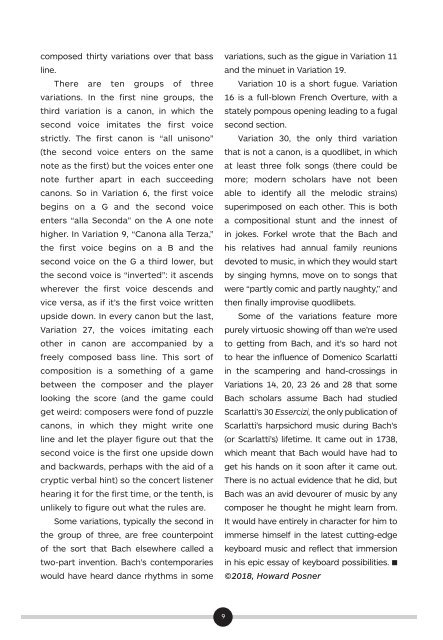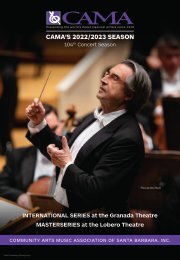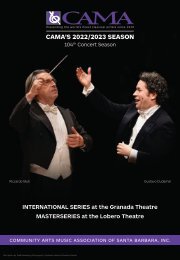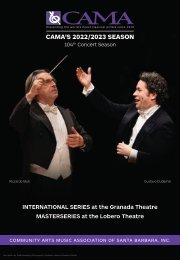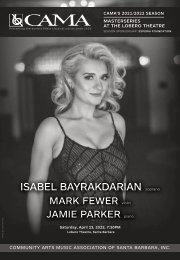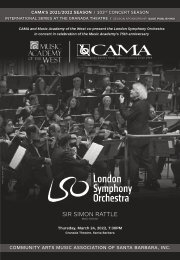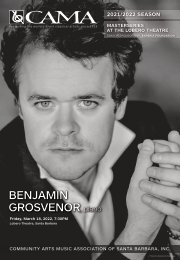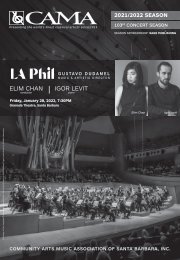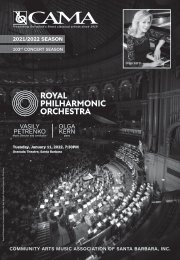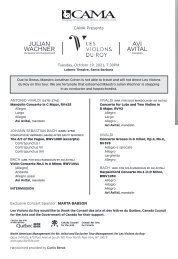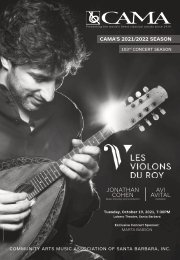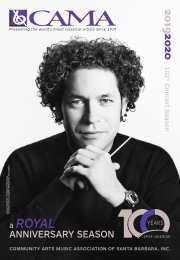CAMA's Masterseries presents Peter Serkin, piano - Saturday, February 24, 2018, Lobero Theatre, Santa Barbara, 8PM
CAMA's Masterseries at The Lobero Theatre presents Peter Serkin, piano Saturday, February 24, 2018 Lobero Theatre, Santa Barbara, California, 8pm Wolfgang Amadeus Mozart: Adagio in B minor, K.540 Wolfgang Amadeus Mozart: Sonata No.17 in B-flat Major, K.570 Johann Sebastian Bach: The Goldberg Variations, BWV 988 The distinguished American pianist Peter Serkin‘s rich musical heritage extends back several generations: his father was pianist Rudolf Serkin and his grandfather violinist/composer Adolf Busch. Recognized over the past five decades as a major artist of deep passion and integrity, his inspired performances and recordings have successfully conveyed the essence of nearly five centuries of keyboard repertoire and been lauded worldwide. He returns for his fifth Masterseries appearance with an Apollonian program of Mozart, plus Bach’s immortal Goldberg Variations.
CAMA's Masterseries at The Lobero Theatre presents
Peter Serkin, piano
Saturday, February 24, 2018
Lobero Theatre, Santa Barbara, California, 8pm
Wolfgang Amadeus Mozart: Adagio in B minor, K.540
Wolfgang Amadeus Mozart: Sonata No.17 in B-flat Major, K.570
Johann Sebastian Bach: The Goldberg Variations, BWV 988
The distinguished American pianist Peter Serkin‘s rich musical heritage extends back several generations: his father was pianist Rudolf Serkin and his grandfather violinist/composer Adolf Busch. Recognized over the past five decades as a major artist of deep passion and integrity, his inspired performances and recordings have successfully conveyed the essence of nearly five centuries of keyboard repertoire and been lauded worldwide. He returns for his fifth Masterseries appearance with an Apollonian program of Mozart, plus Bach’s immortal Goldberg Variations.
You also want an ePaper? Increase the reach of your titles
YUMPU automatically turns print PDFs into web optimized ePapers that Google loves.
composed thirty variations over that bass<br />
line.<br />
There are ten groups of three<br />
variations. In the first nine groups, the<br />
third variation is a canon, in which the<br />
second voice imitates the first voice<br />
strictly. The first canon is “all unisono”<br />
(the second voice enters on the same<br />
note as the first) but the voices enter one<br />
note further apart in each succeeding<br />
canons. So in Variation 6, the first voice<br />
begins on a G and the second voice<br />
enters “alla Seconda” on the A one note<br />
higher. In Variation 9, “Canona alla Terza,”<br />
the first voice begins on a B and the<br />
second voice on the G a third lower, but<br />
the second voice is “inverted”: it ascends<br />
wherever the first voice descends and<br />
vice versa, as if it’s the first voice written<br />
upside down. In every canon but the last,<br />
Variation 27, the voices imitating each<br />
other in canon are accompanied by a<br />
freely composed bass line. This sort of<br />
composition is a something of a game<br />
between the composer and the player<br />
looking the score (and the game could<br />
get weird: composers were fond of puzzle<br />
canons, in which they might write one<br />
line and let the player figure out that the<br />
second voice is the first one upside down<br />
and backwards, perhaps with the aid of a<br />
cryptic verbal hint) so the concert listener<br />
hearing it for the first time, or the tenth, is<br />
unlikely to figure out what the rules are.<br />
Some variations, typically the second in<br />
the group of three, are free counterpoint<br />
of the sort that Bach elsewhere called a<br />
two-part invention. Bach’s contemporaries<br />
would have heard dance rhythms in some<br />
variations, such as the gigue in Variation 11<br />
and the minuet in Variation 19.<br />
Variation 10 is a short fugue. Variation<br />
16 is a full-blown French Overture, with a<br />
stately pompous opening leading to a fugal<br />
second section.<br />
Variation 30, the only third variation<br />
that is not a canon, is a quodlibet, in which<br />
at least three folk songs (there could be<br />
more; modern scholars have not been<br />
able to identify all the melodic strains)<br />
superimposed on each other. This is both<br />
a compositional stunt and the innest of<br />
in jokes. Forkel wrote that the Bach and<br />
his relatives had annual family reunions<br />
devoted to music, in which they would start<br />
by singing hymns, move on to songs that<br />
were “partly comic and partly naughty,” and<br />
then finally improvise quodlibets.<br />
Some of the variations feature more<br />
purely virtuosic showing off than we’re used<br />
to getting from Bach, and it’s so hard not<br />
to hear the influence of Domenico Scarlatti<br />
in the scampering and hand-crossings in<br />
Variations 14, 20, 23 26 and 28 that some<br />
Bach scholars assume Bach had studied<br />
Scarlatti’s 30 Essercizi, the only publication of<br />
Scarlatti’s harpsichord music during Bach’s<br />
(or Scarlatti’s) lifetime. It came out in 1738,<br />
which meant that Bach would have had to<br />
get his hands on it soon after it came out.<br />
There is no actual evidence that he did, but<br />
Bach was an avid devourer of music by any<br />
composer he thought he might learn from.<br />
It would have entirely in character for him to<br />
immerse himself in the latest cutting-edge<br />
keyboard music and reflect that immersion<br />
in his epic essay of keyboard possibilities. n<br />
©<strong>2018</strong>, Howard Posner<br />
9


